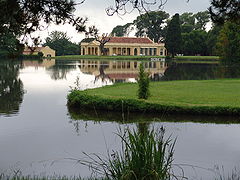
Estancias
Encyclopedia

Ranch
A ranch is an area of landscape, including various structures, given primarily to the practice of ranching, the practice of raising grazing livestock such as cattle or sheep for meat or wool. The word most often applies to livestock-raising operations in the western United States and Canada, though...
. The term is used in Argentina
Argentina
Argentina , officially the Argentine Republic , is the second largest country in South America by land area, after Brazil. It is constituted as a federation of 23 provinces and an autonomous city, Buenos Aires...
, Uruguay
Uruguay
Uruguay ,officially the Oriental Republic of Uruguay,sometimes the Eastern Republic of Uruguay; ) is a country in the southeastern part of South America. It is home to some 3.5 million people, of whom 1.8 million live in the capital Montevideo and its metropolitan area...
and southern Chile
Zona Austral
The Zona Austral is one of the five natural regions into which CORFO divided continental Chile in 1950 corresponding to the Chilean portion of Patagonia. It is surrounded by the Southern Zone and the Chacao Channel to the north, the Pacific Ocean and Drake's Passage to the south and west, and the...
. The equivalent in other Latin American countries would be hacienda
Hacienda
Hacienda is a Spanish word for an estate. Some haciendas were plantations, mines, or even business factories. Many haciendas combined these productive activities...
, or fazenda
Fazenda
Fazendas were coffee plantations that spread into the interior of Brazil between 1840 and 1896. They created major export commodities for Brazilian trade, but also led to intensification of slavery in Brazil.- Creation of fazendas :...
(only in Brazil
Brazil
Brazil , officially the Federative Republic of Brazil , is the largest country in South America. It is the world's fifth largest country, both by geographical area and by population with over 192 million people...
).
Unlike an hacienda, which could be any type of agricultural venture, producing grain, coffee, vegetable, beef, etc., an estancia, most typically located in the southern South American grasslands, the pampas, has historically always been a livestock (cattle or sheep) estate.
During the first centuries of Spanish colonial rule, cattle introduced by the Spanish roamed free and man undertook raids to catch and slaughter them.
In the 19th century stationary ranching ventures started to form in the pampas, with permanent buildings and marked livestock with clearly defined ownership. They were called estancias, the term indicating the stationary, permanent character.
The estancia's ranch worker on horseback, the gaucho
Gaucho
Gaucho is a term commonly used to describe residents of the South American pampas, chacos, or Patagonian grasslands, found principally in parts of Argentina, Uruguay, Southern Chile, and Southern Brazil...
, is of similar importance to national folklore and identity to the cowboy
Cowboy
A cowboy is an animal herder who tends cattle on ranches in North America, traditionally on horseback, and often performs a multitude of other ranch-related tasks. The historic American cowboy of the late 19th century arose from the vaquero traditions of northern Mexico and became a figure of...
in North America.
In recent decades agriculture has intensified and often shifted from livestock to crop farming in the pampas of Argentina and Uruguay, due to the region’s high soil fertility.
A small number of estancias, particularly those with historic architecture have been converted into guest ranches, parador
Parador
A parador , in Spain and other Spanish-speaking countries, is a kind of luxury hotel, usually located in a historic building such as a monastery or castle. Parar means to stop, halt or stay.- Paradores de Turismo de España :...
es, in Argentina and Uruguay as well as in Paraguay or Chile.
Several cities and villages, mainly but not exclusively in Latin America, grew out of such estancias and are named accordingly, for example:
- EstânciaEstânciaEstância is a municipality located in the Brazilian state of Sergipe. Its population was 62,218 and its area is 642 km². The city is the seat of the Roman Catholic Diocese of Estância....
in SergipeSergipeSergipe , is the smallest state of the Brazilian Federation, located on the northeastern Atlantic coast of the country. It borders on two other states, Bahia to the south and west and Alagoas to the north, and to the east is the Atlantic Ocean...
state, BrazilBrazilBrazil , officially the Federative Republic of Brazil , is the largest country in South America. It is the world's fifth largest country, both by geographical area and by population with over 192 million people... - Estancia, IloiloEstancia, IloiloEstancia is a 2nd class municipality in the province of Iloilo, Philippines. According to the 2007 census, it has a population of 39,479 people....
in the province of IloiloIloiloIloilo is a province of the Philippines located in the Western Visayas region. Iloilo occupies the southeast portion of Panay Island and is bordered by Antique Province to the west and Capiz Province and the Jintotolo Channel to the north. Just off Iloilo's southeast coast is Guimaras Province,...
, PhilippinesPhilippinesThe Philippines , officially known as the Republic of the Philippines , is a country in Southeast Asia in the western Pacific Ocean. To its north across the Luzon Strait lies Taiwan. West across the South China Sea sits Vietnam...
. - Estancia El Brete, Salta ProvinceSalta ProvinceSalta is a province of Argentina, located in the northwest of the country. Neighboring provinces are from the east clockwise Formosa, Chaco, Santiago del Estero, Tucumán and Catamarca. It also surrounds Jujuy...
, ArgentinaArgentinaArgentina , officially the Argentine Republic , is the second largest country in South America by land area, after Brazil. It is constituted as a federation of 23 provinces and an autonomous city, Buenos Aires...

